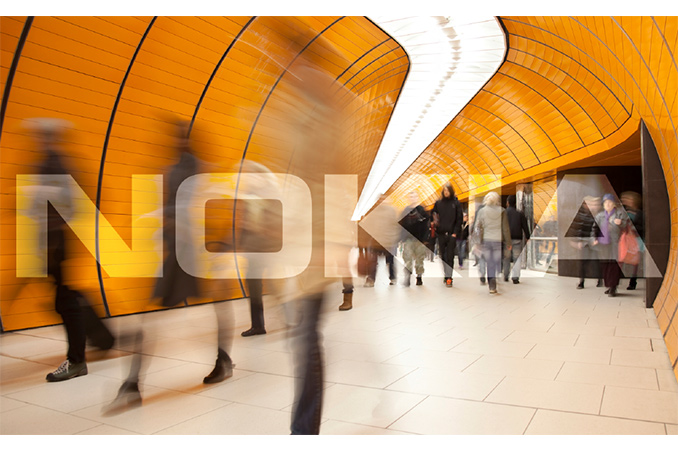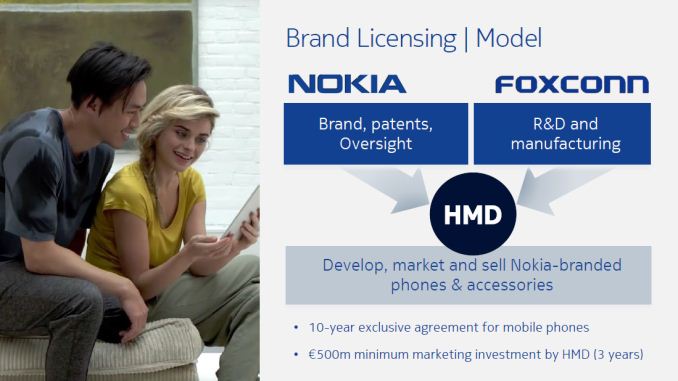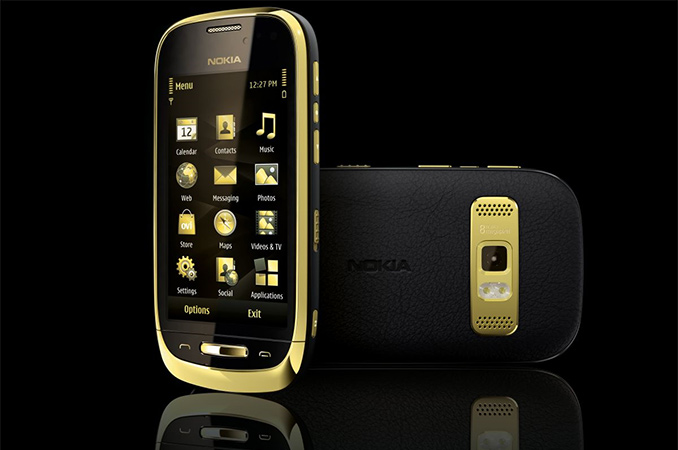HMD Closes Nokia Brand and Patents Deal with Microsoft, Smartphones Due in 2017
by Anton Shilov on December 2, 2016 5:00 PM EST- Posted in
- Smartphones
- Microsoft
- Nokia
- Foxconn
- HMD Global

HMD Global and FIH Mobile on Thursday announced that they had completed their buyout of Nokia assets from Microsoft which opens a way for return of Nokia branded smartphones to the market. As expected, HMD and FIH will keep selling Nokia-branded feature phones in developing countries but will add a range of android-based smartphones and tablets to the lineup in 2017. The two companies hope that relationships with operators as well as manufacturing assets (Foxconn) will be instrumental for making their endeavor a success.
As reported earlier this year, HMD Global and FIH Mobile, a subsidiary of Hon Hai/Foxconn Technology Group (we will call the company “Foxconn” for simplicity), paid Microsoft approximately $350 million in cash for various Nokia-related assets. Under the terms of the agreement, HMD got exclusive rights to use the Nokia brand on mobile phones and tablets globally (except Japan) for the next 10 years, standard essential cellular patent licenses, software for feature phones and some other intellectual property. Meanwhile, Foxconn got a manufacturing facility in Hanoi, Vietnam, which is used to manufacture Nokia-branded devices along with customer contracts, critical supply agreements, sales and distribution assets (in fact, these will be owned by a subsidiary of FIH called TNS and HMD will have rights to acquire TNS over the next ten years) and so on. HMD and Foxconn will jointly develop, manufacture and sell Nokia-branded devices, whereas Nokia will participate in development and will receive royalties covering both brand and IP rights from HMD for sales of every Nokia-branded product. The three companies are poised to work together because they critically depend on assets owned by each other.
In its announcement on Thursday, HMD reaffirmed plans to introduce a range of Android-based smartphones and tablets in 2017. The company’s announcement was short on details, but it confirmed that the devices will be jointly developed with Foxconn under supervision of Nokia (which intends to control certain aspects of design, performance, and feature-set of the devices), who has know-hows not only in high-volume manufacturing but also in device engineering. Given the short amount of time that HMD, Foxconn and Nokia had to design their new devices, expect the latter to use already known hardware platforms, but add certain elements for differentiation. We do know that Nokia has developed its own UI for Android called Z Launcher, hence it is logical to expect the company to expand the project for Nokia-branded smartphones. Meanwhile, since a lot of important Nokia IP (e.g., PureView imaging, ClearBlack display, etc.) remains at Microsoft, three companies will have to either develop certain technologies from scratch or use off-the-shelf solutions. Such approach has pros and cons: on the one hand, it is hard to create a unique device based on popular platforms; on the other hand, it is possible to build a device in a relatively short amount of time. Hence, expect HMD Foxconn and Nokia to reveal their first smartphone already in the first half of 2017.
Right now, the core business of HMD and Foxconn is Nokia-branded feature phones that are popular primarily in developing countries. On Thursday, HMD also announced the Nokia 216 handset with a 2.4” display running the Nokia 30-series software that will be inexpensive but will still provide basic “smart” functionality like Internet browsing and multimedia playback. Even though sales of such phones are rapidly decreasing, there are still hundreds of millions of such devices sold every year. HMD naturally hopes that it will be able to replace feature phones with inexpensive smartphones and thus will capture a sizeable chunk of the market. As such, expect HMD to focus on not only advanced models for the U.S. and Europe, but also on affordable smartphones for countries like India and Russia, where the brand is particularly strong and where reasonably priced phones are popular. From a market share point of view, inexpensive models are more important than the flagship devices. Nonetheless, Xiaomi and some other makers clearly demonstrated how fine flagship devices affect brand recognition, hence, they are crucial for success.
Wrapping things up, the deal between Microsoft, HMD Global and FIH Mobile is now closed and Nokia-branded smartphones (and tablets) are on their way back to the market. It is unlikely that we will hear about them anything at CES, but HMD Global will be present at MWC 2017 and this is where the firm will likely showcase at least some of the upcoming products or at least their key features.
Related Reading:
- Nokia Is Set to Return to Smartphones and Tablets: What to Expect?
- Microsoft Streamlines Its Smartphone Business Again, Lays Off 1850 People
- HP’s Elite x3 Windows 10 Smartphone to Cost $699, Set to Be Available Worldwide
Sources: HMD Global, FIH Mobile, Nokia.












28 Comments
View All Comments
close - Sunday, December 4, 2016 - link
@kspirit, ddriver is everywhere spreading his "I am better than all of thou" gospel. Every article, every discussion, he's there with his horrible pseudo-engineering speech and his attempts to sound like an expert in everything looking down on everyone else.And every time someone points out the countless times his "predictions" proved to be as valuable as a stick in the mud he whips out the good ol' "you're just a troll, you probably don't understand".
Just in case you are not familiar with him, he claims to have invented (designed, did all the necessary calculations for) a 5.25" hard drive that's better than anything on the market but the big manufacturers sit on it to sell their crappy "normal" drives.
Also his scenario for a typical media content server is 2 users accessing 2 pictures simultaneously which means a hard drive is enough since hard drives are faster than any network connection (his knowledge stops at 1Gb Ethernet).
ddriver - Sunday, December 4, 2016 - link
A couple of centuries ago on the streets of Imperial Japan people would just squat, lift up their kimonos and lay a brick wherever they feel like it.There were those lowest members of society, whose job was to be watchful of this, and when somebody does his business, they would immediately rush to collect the feces with great care to use as fertilizer for the rice paddies.
And no, I am not implying you are like them, wouldn't want to offed them, those guys were actually very useful, important and productive members of society... unlike you ;)
Shadow7037932 - Monday, December 5, 2016 - link
Don't you have anything more productive to do with your life than comment on AT articles?cLOWNgOD - Monday, December 5, 2016 - link
ddiverOf the two "epic Fails" you mentioned, you can really only credit Nokia with one of them. When Nokia made it known they were moving to Android, Microsoft quickly slid their trojin horse Elop into play.
Don't get me wrong, they actually still could have made the phone work on Windows. Unfortunately Nadela wound up being an even bigger dope than Ballmer.
So.. in spite of "..the tons of money and strings M$ can pull" he decided not to assign any of the Umpteen BILLION developers at his disposal to cover even basic apps need in the app. store. And as anyone in the phone business will tell you, that's Game-Set - and match!
Meteor2 - Saturday, December 3, 2016 - link
I'd be happy to see Nokia back. If they build good, balanced phones around the OnePlus3 mark they could do very well.And don't underestimate the power of nostalgia; I bet plenty of people would pay luxury phone prices for a suitably-specced Nokia just because they remember phones like the 3310 so fondly.
serendip - Sunday, December 4, 2016 - link
I've been using Z Launcher since it first came out but it looks more like abandonware at this point. The UI doesn't scale for large, high resolution screens so you get huge spacing with tiny fonts. It took me a while to go back to an icon-based launcher like Action Launcher but I'm glad I did.As for Nokia's third resurrection in mobile, I'm not impressed. Nokia tried making Android devices before but those were overpriced and didn't sell well. Symbian, S40, Maemo, Meego all are dead, along with the zombie remnants of Windows Phone/Mobile. Making cheap Android devices isn't good enough when there are Xiaomi and Huawei devices that are cheap and have innovative features. So what innovation does Nokia have that others don't?
tuxRoller - Sunday, December 4, 2016 - link
Eh, different launchers work best with different screen sizes.I still(!) use Z launcher on my phone, but on my tablet I stick with google now (though I've also got action launcher, which is quite good).
What "nokia" can bring to the table, if they want, are: low bloatware experience->easy upgrade path, well optimized software (not really as hard as most oems make it look), DURABLE devices (doesn't break on drops, but will probably scratch).
To achieve the above you'll need a disciplined team, with management "leading" the way. You'll also have to sacrifice on some things: screen quality (unfortunately really consistently good screen quality seems beyond humanity's ability without "per device calibration"), looks (maybe....), and certainly the benchmarks all of the tech sites run.
So, more or less, follow the Pixel model minus the extraneous ui customization and highend hardware.
Michael Bay - Sunday, December 4, 2016 - link
And end with negative margins. Hell, if you`re not Samsung or Apple, you`re in the red already.tuxRoller - Sunday, December 4, 2016 - link
Umm....http://www.fool.com/investing/2016/12/03/guess-who...
So....no?
Michael Bay - Monday, December 5, 2016 - link
>one citationYeah, nice evidence of epic profitability in the race to the bottom. Of chink company at that.